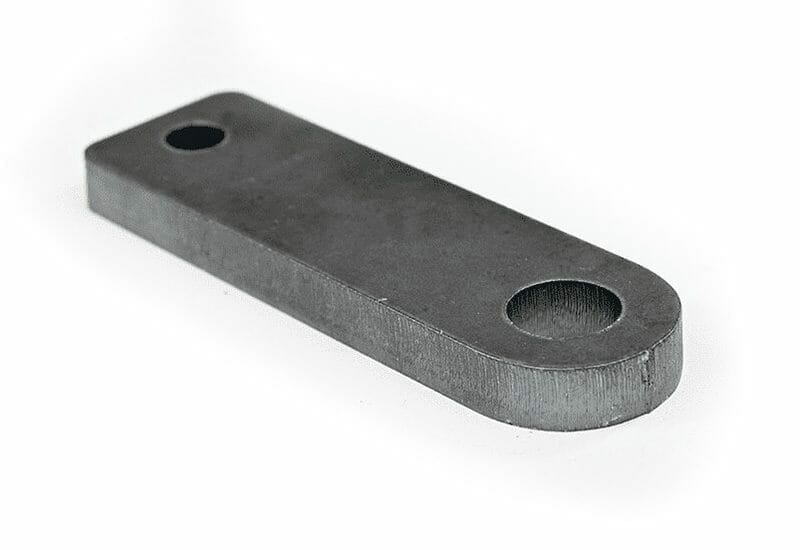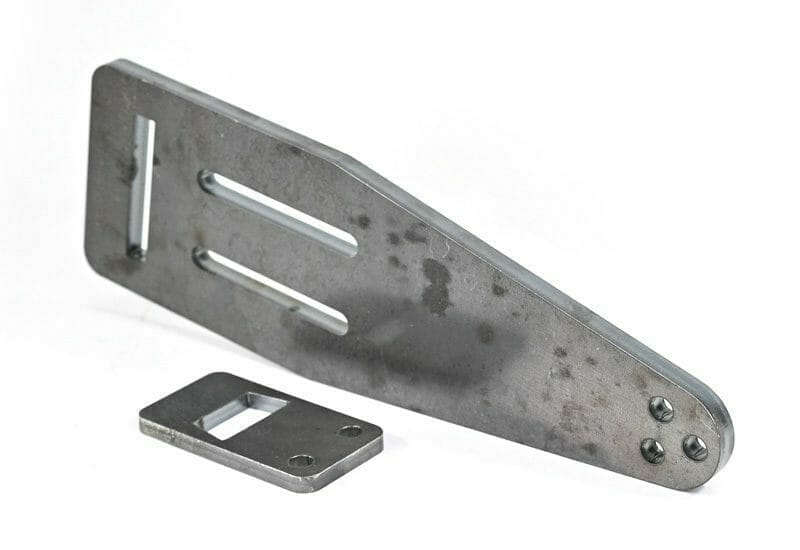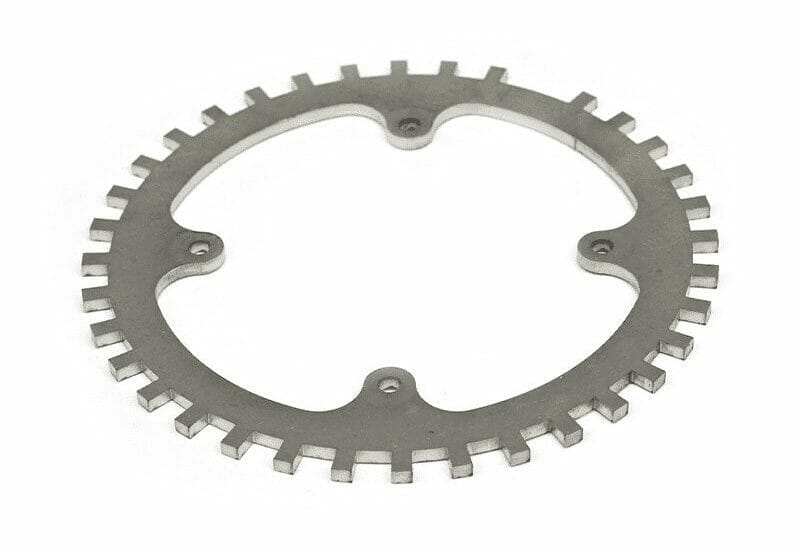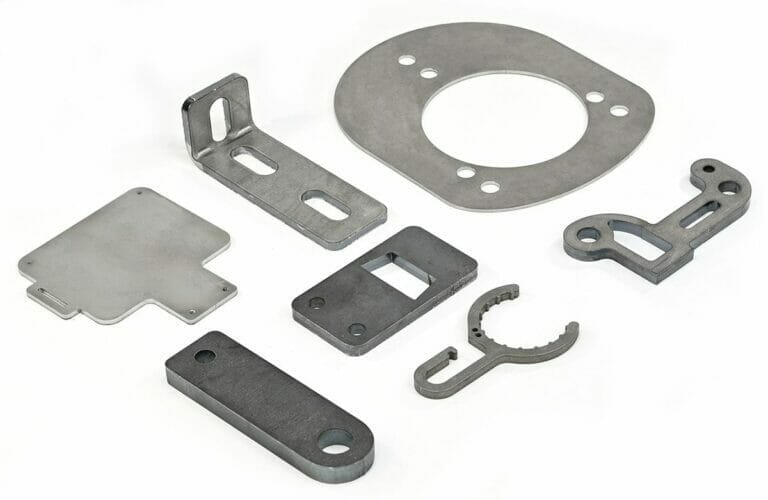Core differences between Cold Rolled Steel & Hot Rolled Steel
Mild steel (low carbon steel) is an affordable, workable material that remains a go-to for welders, builders, and fabricators everywhere. We offer three surface finishes for mild steel here at SendCutSend: Cold Rolled (1008), Hot Rolled (A36), and Hot Rolled Pickled and Oiled (A36). Each one brings its own unique value to a project, and they have a few key differences that are important to know.
Hot Rolled Carbon Steel (A36) Sheet Metal Overview

Hot rolled carbon steel is heated to temperatures that exceed the material’s recrystallization temperature. It is vital that the steel reach a temperature greater than ~1700°F because only then is it able to be rolled, formed, and shaped without cracking or breaking. Once the steel has been formed, it is then allowed to slowly cool to room temperature. Since it’s cooled slowly, hot rolled steel is normalized, making it free from the internal stress that other materials experience during work hardening. This gives the steel high strength properties.
Because the cooling process is imprecise during its forming, hot rolled steel has somewhat inconsistent tolerances and may warp slightly during cooling. For this reason, it’s not recommended that hot rolled steel be used for applications where tight tolerances are of high concern. In addition to warping, hot rolled carbon steel will also have a rough, scaly finish post-cooling. However, this scaling can be removed with some finishing such as grinding or sand-blasting.
What hot rolled carbon steel lacks in precision, however, it makes up for in affordability. Of the three main methods for finishing mild steel, hot rolled is by far the most cost effective because it sustains no further processing post-cooling. This makes it ideal for high quantity applications because it’s budget-friendly. And for all its affordability, hot rolled carbon steel retains the core strength properties that make carbon steel inherently valuable to high strength projects.
Advantages and Disadvantages of Hot Rolled Carbon Steel
Advantages of A36 Hot Rolled Carbon Steel
Lower costs
Compared to other carbon steel options, hot rolled carbon steel requires far less processing and working, making it affordable and accessible for any kind of project.
Easier to work with
Hot rolled carbon steel is easy to manipulate and work with, allowing you to bend and further form it without putting undue stress on the material. Hot rolled carbon steel is one of the materials we offer with our CNC bending services.
Reduced internal stress
Hot rolled steel is cooled at room temperature, normalizing the material and avoiding work hardening or increased hardness due to quenching. Hot rolled steel can be manipulated and put under high stress applications with less potential for failures.
Disadvantages of A36 Hot Rolled Carbon Steel
Slight distortions
Hot rolled carbon steel may experience some distortion due to the heating and warping of the material as it cools slowly. This can affect dimensional thickness, cause surface imperfections, and change the overall tolerances.
Rough texture
Hot rolled carbon steel is known for having scaling on its surface left over after the cooling process. This scaling is rough and oily, and needs to be removed before applying further finishing processes.
The disadvantages of hot rolled steel are mitigated by our material selection and machining processes here at SendCutSend. We source high quality material for your parts, so even our hot rolled steel sees little tolerance and thickness variation across a sheet. Our laser cutting is known for its accuracy and tight tolerances, so we will make sure your laser cut hot rolled carbon steel parts are cut to your exact specs.
Common Applications & Uses of A36 Hot Rolled Carbon Steel Sheet Metal:
Structural components
Thanks to its strength and ability to withstand high stress environments, hot rolled carbon steel is ideal for structural, load-bearing parts in everything from building framing to shop improvement projects.
Vehicle framing
Hot rolled carbon steel is used for durability in oversized vehicle framing, and can add that necessary strength to your next automotive modification. Hot rolled steel is most often used for the chassis and underbody components of vehicles, as well as some structural assemblies.
Construction materials
The surface quality of hot rolled steel is not an issue when it comes to construction materials, where it’s often used in high-strength applications such as I-beams. Hot rolled steel’s affordability lends itself to high volume construction projects and materials as well.
Railroad equipment
Railroad equipment is one of the best applications of hot rolled steel, where surface finish is no issue and the applications don’t require tight tolerances. You’ll find hot rolled steel most often in railroad tracks, but it has structural applications for some trains as well.
Hot Rolled Pickled and Oiled Carbon Steel (A36/A1018) Sheet Metal Overview

Hot rolled pickled and oiled (HRP&O) carbon steel is simply hot rolled carbon steel that has been washed in an acid bath to remove the scaling. The material is then brushed with a dry oil to protect the surface from oxidation and corrosion, making the end result more corrosion resistant than unwashed hot rolled steel.
Although HRP&O is slightly more expensive than its less processed counterpart, it is worth it if your project is going to spend any significant amount of time in aggressive weathering conditions.
Applications:
Guardrails
HRP&O is perfect for guardrails of any kind, with indoor and outdoor applications. Without further finishing, HRP&O is wear and corrosion resistant, and guardrails are subject to heavy weathering and long-term use wherever they are used. With the mill scaling removed, HRP&O is also the more aesthetic carbon steel option, making it perfect for uses in parks, hiking areas, and museums.
Welded structures
HRP&O is one of the best mild steel options for welding because of its smooth, scale-free surface. It eliminates the need for excessive grinding post-welding, allowing you to focus on the quality of the welds rather than the final look and needs of the material.
Long-term outdoor equipment
From playground equipment to farming to fencing, HRP&O suits pretty much any outdoor application. Its corrosion and weathering resistance lends itself to long-term use in harsh environments, and its workability allows you to design and create custom parts with ease.
Cold Rolled Carbon Steel (1008)

Cold rolled carbon steel, or cold finished steel, goes through all the same initial processes as hot rolled, but with a few additional steps to make it more workable and precise. Once the mild steel is cooled completely, it’s then drawn through rollers at room temperature. This process reduces the inconsistencies often found in just hot rolled carbon steel, making it more reliable to work with. It also reduces external scaling and overall warping of the material.
The biggest downside to cold rolled carbon steel is that it is more expensive than hot rolled because of the additional processing costs. Cold rolled steel is also subject to slightly more internal stress due to work hardening, but this process is necessary to achieve cold rolled steel’s characteristic hardness and tension resistance. When a project requires both strength and tight tolerances, cold rolled is a must.
Thanks to its clean edges and higher hardness level, cold rolled carbon steel is also perfect for welded projects. It’s often the first choice for our welding customers who are looking for strength and durability alongside ductility. Cold rolled steel is also better suited for projects where aesthetics should be taken into account since it retains little to no scaling that’s characteristic of hot rolled carbon steel.
Advantages and Disadvantages of Cold Rolled Carbon Steel
Advantages of 1008 Cold Rolled Carbon Steel
Higher strength
Rolling the steel once it’s completely cool hardens the material and increases its tension resistance, making cold rolled carbon steel one of the strongest carbon steel options available.
Increased precision
With less shrinkage and more post-processing done to improve the shaping and tolerances, cold rolled carbon steel can achieve higher precision and is more suited for applications which require tight tolerances.
Best surface properties
Cold rolled carbon steel has little to none of the mill scaling found on untreated hot rolled carbon steel, giving it a relatively smooth and debris-free finish.
Disadvantages of 1008 Cold Rolled Carbon Steel
Higher costs
The further processing and working done to cold rolled steel to achieve the tighter tolerances and better finish also increase the overall cost of the material.
Potential internal stresses
Increased work hardening will increase the internal stress of the metal, leading to unwanted warping further down the line if the material is overworked.
Our machining and processing services are some of the most affordable and high quality available, helping you offset the cost of those more costly and project-critical metals. Our bending and forming guidelines and limitations are also specific to each material, mitigating issues with further work hardening on already hardened materials like cold rolled carbon steel.
Common Applications & Uses of 1008 Cold Rolled Carbon Steel Sheet Metal
Aerospace structures
The precision and tight tolerances cold rolled carbon steel allows for makes it perfectly suited for aerospace applications. Its wear resistance and strength lends itself specifically to structural components and high stress applications.
Furniture
Office furniture such as filing cabinets, desks, and chairs benefit from cold rolled steel’s strength, workability, and clean finish. Cold rolled steel can also be found in kitchen appliances and work tables, lending its durability to these applications.
School lockers
Cold rolled carbon steel is the first choice material for most lockers, allowing the lockers to withstand daily use and long-term wear. Cold rolled steel’s strength is also high enough to allow for locker stacking and overpacking.
Floor decking
Cold rolled steel is used as structural support in floor decking. The strength and stress resistance supports this high use application, and its work hardening prevents slow warping over long-term wear.
Hot Rolled Steel Sheet Metal vs Cold Rolled Steel Sheet Metal: 4 Key Differences
| Properties | Cold Rolled Steel | Hot Rolled Steel |
| Tensile Strength | 85000 PSI | 67000 PSI |
| Yield Strength | 70000 PSI | 45000 PSI |
| Modulus of Elasticity | 27557 – 30458 KSI | 29000 KSI |
| Shear Modulus | 11600 KSI | 11500 KSI |
| Brinell Hardness | 95 | 119-159 |
Surface and appearance differences between Hot Rolled Steel & Cold Rolled Steel
Understanding they key differences in the these types of steel is essential when designing for sheet metal.
Hot rolled steel has mill scaling on its surface, making it rough and uneven. This mill scaling can be removed with light sanding or deburring.
Cold rolled steel is smoother to the touch, with no scaling that needs to be removed. This is thanks to working the material once it’s completely cooled.
Strength and hardness differences between Hot Rolled Steel & Cold Rolled Steel
With a lower yield strength and better workability, hot rolled steel is easily formed and extremely malleable. It is also harder than cold rolled steel because it is formed at high temperatures and cooled slowly.
Cold rolled steel has a higher tensile strength and higher yield strength, allowing it to undergo more stress and wear without warping. It is work hardened during the rolling process and is easily machined.
Internal stress differences between Hot Rolled Steel & Cold Rolled Steel
Hot rolled steel is normalized, meaning it’s cooled slowly and at room temperature. It has little to no internal stresses from work hardening or quenching.
Cold rolled steel experiences more internal stress because it is not heated to a higher temperature than its recrystallization temperature, and is formed completely cool. This work-hardening makes it more difficult to further form and manipulate, but allows the material to meet tighter tolerances.
Distortion differences between Hot Rolled Steel & Cold Rolled Steel
The cooling process for hot rolled steel is imprecise as it happens slowly and at room temperature, allowing imperfections to form in the material. Hot rolled steel is most likely to experience distortion and varying thicknesses from sheet to sheet.
Cold rolled steel experiences none of the same distortion because it is rolled while completely cool, flattening the material to a uniform thickness. This makes cold rolled steel better suited for uses where tight tolerances are needed.
Use Mild Steel Sheet Metal In Your Next Laser Cut Project
Each finish of mild steel has its own wide variety of uses and strengths, and hopefully we have helped you narrow down which one to use in your next project. If you have any further questions about picking the right material for your parts, check out our other material breakdown blog posts or reach out to our support team.
If you’ve already decided on your material or we have convinced you to use mild steel on your next project, upload your files to our website and get instant pricing today!





